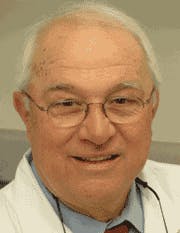All about Altadonics
With his finger always on the pulse of the hottest trends in dentistry, DE® editor Dr. Joe Blaes has discovered a new star in the universe of dentures
Dr. Joe Blaes: We are here today with Dr. William Price, who has practiced dentistry for 35 years and founded a company called Altadonics. Altadonics has developed a revolutionary new denture replacement process that allows denture patients to keep the same comfort of their existing dentures for their entire lifetime. Dr. Price, can you tell us about the need for this new process?
Dr. William Price: In late 1999, I challenged myself to identify my likes and dislikes as a dentist. Making replacement dentures ranked as one of my strongest dislikes because it seemed that, despite all my best efforts, results were seldom predictable. I had just created the fourth replacement set of dentures for a dementia patient named Esther, who kept losing her dentures. With the loss of each subsequent set, I became increasingly aware that not only was it difficult to make her comfortable, but the vast complexities of making replacement dentures were not making the process any easier. I realized that the best dentures Esther ever had were the first set she lost. Why? This set was more than 15 years old, so they weren’t healthy in a pathological sense. In fact, dentures older than five years have been shown to harbor harmful bacteria and should be replaced. Rather, these older dentures were, in a word, comfortable. The proprioception was there, built in over years of wear and natural adaptation taking place in the mouth. I quickly recognized that the attempt to accurately replicate this proprioception makes denture replacement difficult, if not impossible, for us as dentists to offer a comfortable option for our patients in need of replacement dentures. The challenge then became clear: develop a technique that could prevent the loss of the proprioception critical for comfortable dentures. I knew that if we could find a solution then patients would not only become more compliant with their replacements every five to seven years, but dentists could turn this stressful and often money-losing endeavor into a profit center. Up to this point, no one would have ever believed this could be practical for the five- to seven-year denture replacement cycle.
Dr. Blaes: Where is the process performed and how do I get the new denture made? Will I have to invest in additional lab equipment or personnel?
Dr. Price: That’s a great question and one that is near and dear to my heart. Simply put, anyone in the office can perform the process of making the molds without any special rooms or costly equipment. The mold is sent to Altadonics, we make the new denture and send it back within a few days, and the mold is stored long-term in our secure facility. Quite often in dentistry you have to make a tremendous financial investment upfront. Add to that the valuable time dedicated to understanding the process and figuring out how to integrate it into your office flow. Factor all of these things in and the payoff of a new technique is often months if not years away. We approached the design phase of the Assurance Denture process with a goal to make the doctor’s experience with Altadonics “simple and easy.” The kit is all you need to get started - well, the kit and a denture patient, assuming you haven’t referred them all out yet (laugh). The components are pre-measured and arrive at the office in the kit. Once the mold is created, it leaves in the same box; no expensive or bulky machines are necessary. We provide all new accounts with an easy to follow four minute DVD showing how to mix and pour the molding material. We knew we had accomplished our goal when the camera crew that shot the video was able to create a mold.
Dr. Blaes: Where do you archive the mold? What if I request a denture in five years or so and the patient’s mouth has changed?
Dr. Price: We store the molds in a former corporate bank vault that is climate-controlled, and we have developed a proprietary computer program for tracking the location and status of each mold once it enters the building. Because the mold contains the critical information that is vital to restoring a denture patient back to comfort, we take no chances when it comes to keeping the mold secure. While some mouths will change slightly over the course of time, a simple reline procedure we have developed for use with our technique usually resolves these issues. The important thing to remember is that you get a tremendous head start toward restoring your patient back to comfort with our replacement discipline. When it comes to denture replacement you essentially have two choices: you can start with a denture created from an impression that the at one time fully corresponded to the patient, or start over without any references or guides. In dentistry you don’t get paid a premium for guesswork, and I have found that the guesswork makes the denture replacement process difficult for patients and doctors.
Dr. Blaes: How much do you recommend charging patients for the replacement denture made using the Altadonics process?
Dr. Price: This question is perhaps best addressed by referencing my own practice. In my practice, I have provided my patients with a replacement denture at our existing denture fee. The Altadonics kit and denture combination is priced low enough to allow both the patient and the doctor to function under the current denture cost structure while enhancing the benefits for both. The doctor benefits from predictability - a word rarely associated with dentures - and reduced operating time, while the patient benefits from the system’s unsurpassed comfort.
Dr. Blaes: Of the denture patients in the typical practice who have comfortable dentures and are candidates for the service, how many do you think would opt for the service if offered?
Dr. Price: I continue to be amazed at the responses I get from patients once they understand what they are being offered. Some with dentures in excess of 20 years old even think that a mold exists for their denture! The key to getting a high “yes” response is simply understanding the offering and conveying the benefits to the patient. With proper communication, achieving a near 100 percent conversion is possible because you are talking about their comfort, and who doesn’t want to be comfortable if given a choice?
Dr. Blaes: Why hasn’t this been thought of earlier?
Dr. Price: Old paradigms are easy to repeat and difficult to change. It amazes me that dentistry, despite all the lasers and digital advances, still uses methods that date back to the 1870s, when Goodyear patented vulcanite rubber for producing dentures. The major problem with the current method is that the stone mold is destroyed. All that critical information that could give the doctor a head start into making future replacements is flushed down the drain of your lab. Consequently, the 52 million dentures that are unique to their owners cannot be easily replaced or enhanced as time goes by. By capturing the information accurately in an easy-to-use pourable material, we can store and, most importantly, restore the patient’s denture comfort without having to start over.
Dr. Blaes: Provided they offer their patients a replacement denture option, why would our audience change their current replacement process over to Altadonics?
Dr. Price: The Altadonics system distinguishes itself by providing the capability to deliver accurate and predictable results over the long term. Denture replacement depends on translating what I call the “comfort critical” information from the old, comfortable denture to the replacement denture. If you are counting on a high degree of predictability, you want to utilize a storage agent that can capture and preserve the full character of the old denture without distortions. While most denture replacement methods marketed today utilize a water-based alginate, Altadonics uses a high-grade platinum-based rubber that doesn’t distort and can withstand the rigors of long-term storage, allowing our customers to provide a comfortable replacement denture within a matter of days to the patient, who will probably say that he or she can’t tell the difference from the old appliance. Additionally, the dentist has created a high-profit procedure that can be repeated over the recommended five- to seven-year denture replacement cycle for the patient.
Dr. Blaes: So, is this what I understand - the Altadonics process provides predictability, efficiency, lower stress for the patient and doctor, fewer appointments, and higher profitability?
Dr. Price: Yes, you can now provide better patient care and improve your profitability in 20 minutes or less.
Dr. Blaes: This sounds like a great system. How can one get more information on Altadonics?
Dr. Price: We can be reached via email at [email protected], through our Web site at www.altadonics.com, or by calling (866) 221-7061 or direct at (336) 722-0071.

